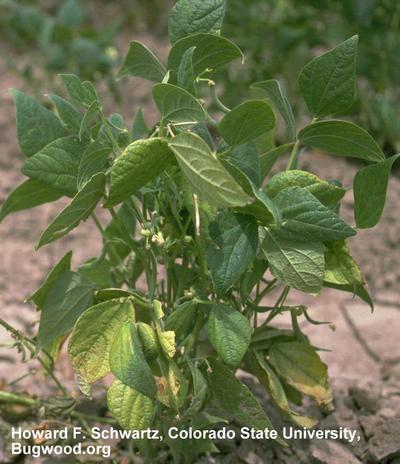Dry Root Rot of Bean
Fusarium solani f. sp. phaseoli
Fungus
In a Nutshell
- Leaves of seedlings can turn yellow and start to wilt.
- Reddish lesions appear on the main root shortly after plant emergence.
- These lesions may turn dark brown, coalesce and develop cracks along the root axis.
- The tissues do not become soft and moldy, thereby the other common name of the disease "dry root rot".
- If they survive, infected plants only grow a few pods with few seeds.
Can also be found in
Symptoms
A few weeks after sowing, the leaves of infected seedlings can turn yellow and start to wilt. The plants may be stunted and can die shortly after emergence if the environmental conditions favor the disease. Underground symptoms appear as reddish lesions or streaks on the main root only one week after emergence. These lesions may turn dark brown, coalesce and as they dry, they develop into cracks along the root axis. Lateral roots and root tips shrivel and die but persist on plants. New fibrous roots can develop above these lesions, closer to the soil line. The tissues do not become soft and moldy, thereby the other common name of the disease "dry root rot". If they survive the adverse conditions, plants only grow a few pods with few seeds.
Recommendations

Organic Control
Seed treatments with biocontrol agents such as Bacillus subtilis with Rhizobium tropici might work. Other treatments with microorganisms include solutions based on Trichoderma harzianum.

Chemical Control
Always consider an integrated approach with preventive measures along with biological treatments. Fungicides are generally not effective in controlling fusarium root rot.
What caused it?
Fusarium root rot is caused by the fungus Fusarium solani, which can survive in debris in the soil for several years. The fungus penetrates the growing seedling shortly after germination and settles in the water and nutrient transport tissues. The presence of the fungus there usually causes little damage to unstressed, healthy plants. However, if the environmental conditions are adverse (drought, flooded soils, poor nutrition, deep planting, compacted soils, herbicide injury), the blocked water and nutrient transport leads to added stress and to the appearance of symptoms. Important yield losses can be expected in this case.
Preventive Measures
- Use tolerant or resistant varieties if available in your market.
- Plant in shallow seedbeds or in furrows.
- Sow the field rather late in the season when soils are warmer.
- Keep a wider space between plants.
- Improve drainage of the fields.
- Water the plants regularly to avoid drought stress.
- Minimize soil compaction and the formation of hard soil pans.
- Provide good fertilization.
- Be careful not to injure the plants during field work.
- Long-term rotation of 4 to 5 years with non-leguminous crops is recommended.
- Plow deep to bury plant debris.
- Till the land and use soil solarization.
- Do not feed the bean straw of infected plants to animals.
- The manure will carry the fungus.



